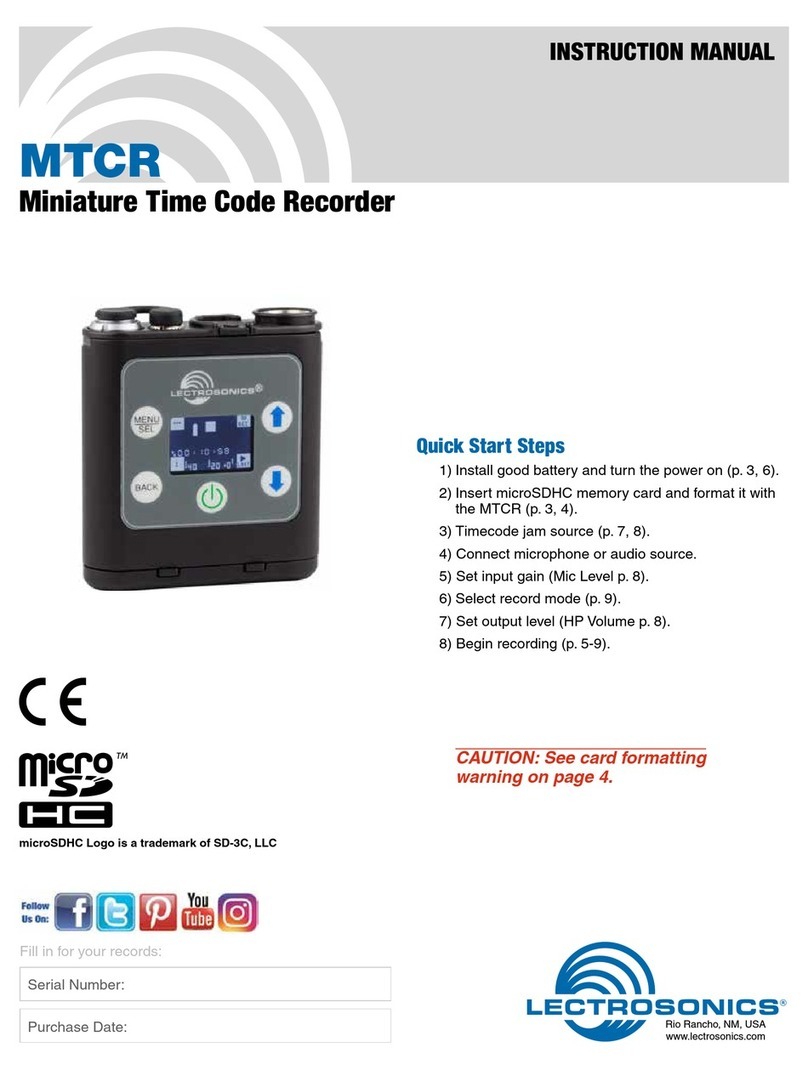
SPDR
LECTROSONICS, INC.
4
Introduction
The second recorder from Lectrosonics, the SPDR
(Stereo Portable Digital Recorder) delivers advanced
technology and features, including stereo mode with
two channels available. As a backup recorder in a bag,
the recorder is small, yet packed with features, including
extended run time, optional external power and higher
sample rates.
On occasion, there is a need to record high quality, ste-
reo audio in circumstances where a traditional full sized
recorder is impractical or when a reliable backup is
needed. When talent is at an extreme distance or using
a wireless microphone is not practical (knights in armor
come to mind), the SPDR can travel with your subject
and record professional quality stereo audio, synchro-
nized with timecode.
The SPDR can be tethered to a camera to capture a
higher quality or backup audio recording. The head-
phone output doubles as a line output to feed the AV
input on a camera.
Setup and adjustment is made through an intuitive
interface provided by the keypad and LCD. The housing
is an aluminum extrusion with machined aluminum top
and control panels, as well as a hard anodized finish.
Technical Highlights
Broadcast Wave Format
With a timecode jam at the start of the production, the
audio data file contents include a timing reference to
make it easy to synchronize with a video track in the
time line. The industry standard BWF/.WAV file format
is compatible with essentially any audio or video editing
software.
iXML HEADER SUPPORT
Recordings contain industry standard iXML chunks in
the file headers, with the most commonly used fields
filled in.
Standard TA5 mic/line inputs
The input connectors are the industry standard TA5M
jacks that accept analog mic or line level signals. If
using mic inputs, the SPDR provides bias voltage to
power a wide variety of electret lavaliere microphones.
The input connection and wiring is compatible with
microphones pre-wired for “compatible” and “servo bias”
configurations to feed 5-pin inputs on Lectrosonics wire-
less microphone transmitters.
AES3 Digital Input
An optional digital input is available with a suggested
Lectrosonics MCAES3 cable to connect the output to
the AES3 digital input of a mixer or recorder; TA5F jack
to 3-pin female XLR connector.
Timecode Support
Timecode can be copied from the internal real time
clock, for projects where it is desirable for timecode to
approximately match time of day but it is not necessary
to synchronize with other devices. Timecode can also
be “jammed” from an external source.
Timecode defaults to zero at power up if no timecode
source is used to jam the unit. A timing reference is
logged into the BWF metadata.
Dual Sample Rates
The SPDR has two sample rate options available (48
kHz and 96 kHz); 48 kHz is an industry standard rate
and should be suitable for nearly all purposes. At 96
kHz, the microSDHC memory card will be used up
twice as fast, but will have slightly less phase distortion
near the top end of the audible spectrum (close to
20 kHz).
Linked vs. Independent Stereo
The Linked Stereo option operates limiters on both
channels together to preserve the balance of the stereo
image. Use Independent Stereo when you have two
separate sounds/voices and each input will have a
separate limiter.
Split Gain Mode
There are two recording modes available in the menu,
HD Mono, which records a single audio track and Split
Gain, which records two different tracks, one at the nor-
mal level and another at -18 dB as a “safety” track that
can be used in place of the normal track in the event
that overload distortion (clipping) has occurred on the
normal track. In either mode, recordings over 4GB are
broken into sequential segments so very long record-
ings (over approx 5 hours in HD mode or 2.5 hours in
split mode) will not be a single file.
Dual Power Sources
The SPDR has an external power input with internal
battery switch over, allowing all day recording with im-
mediate fall back to the internal batteries should there
be an external power loss.




























